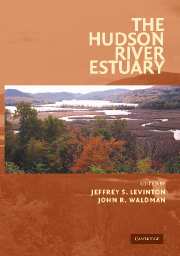Book contents
- Frontmatter
- Contents
- Preface
- List of Contributors
- The Hudson River Estuary
- 1 The Hudson River Estuary: Executive Summary
- GEOLOGICAL, PHYSICAL, AND CHEMICAL SETTING OF THE HUDSON
- PRIMARY PRODUCTION, MICROBIAL DYNAMICS, AND NUTRIENT DYNAMICS OF THE HUDSON
- 8 Bacterial Abundance, Growth, and Metabolism in the Tidal Freshwater Hudson River
- 9 Primary Production and Its Regulation in the Tidal-Freshwater Hudson River
- 10 Wastewater and Watershed Influences on Primary Productivity and Oxygen Dynamics in the Lower Hudson River Estuary
- 11 Modeling Primary Production in the Lower Hudson River Estuary
- HUDSON RIVER COMMUNITIES, FOOD WEBS, AND FISHERIES
- CONTAMINANTS AND MANAGEMENT ISSUES OF THE HUDSON RIVER ESTUARY
- Index
- Plate section
- References
10 - Wastewater and Watershed Influences on Primary Productivity and Oxygen Dynamics in the Lower Hudson River Estuary
Published online by Cambridge University Press: 06 January 2010
- Frontmatter
- Contents
- Preface
- List of Contributors
- The Hudson River Estuary
- 1 The Hudson River Estuary: Executive Summary
- GEOLOGICAL, PHYSICAL, AND CHEMICAL SETTING OF THE HUDSON
- PRIMARY PRODUCTION, MICROBIAL DYNAMICS, AND NUTRIENT DYNAMICS OF THE HUDSON
- 8 Bacterial Abundance, Growth, and Metabolism in the Tidal Freshwater Hudson River
- 9 Primary Production and Its Regulation in the Tidal-Freshwater Hudson River
- 10 Wastewater and Watershed Influences on Primary Productivity and Oxygen Dynamics in the Lower Hudson River Estuary
- 11 Modeling Primary Production in the Lower Hudson River Estuary
- HUDSON RIVER COMMUNITIES, FOOD WEBS, AND FISHERIES
- CONTAMINANTS AND MANAGEMENT ISSUES OF THE HUDSON RIVER ESTUARY
- Index
- Plate section
- References
Summary
abstract Primary productivity in the saline Hudson River estuary is strongly regulated by water residence times in the estuary. Nutrient loads and concentrations are very high, and when residence times are more than two days, production is extremely high. When water residence times are less than two days, production rates are low to moderate. Residence times are controlled both by freshwater discharge into the estuary and by tidal mixing, so residence times are longest and production is highest during neap tides when freshwater discharge is low. Freshwater discharge was generally high in the 1970s, which kept primary production low. In contrast, freshwater discharge rates were lower in the 1990s, and the estuary became hypereutrophic.
Nutrient loading per area of estuary to the saline portion of the Hudson is probably the highest for any major estuary in North America. As of the 1990s, approximately 58 percent of the nitrogen and 81 percent of the phosphorus came from wastewater effluent and other urban discharges in the New York City metropolitan area. Some 42 percent of the nitrogen and 19 percent of the phosphorus came from upriver tributary sources. For nitrogen, these tributary inputs are dominated by nonpoint sources, with atmospheric deposition from fossil fuel combustion and agricultural sources contributing equally. Human activity has probably increased nitrogen loading to the Hudson estuary twelve-fold and phosphorus loading fifty-fold or more since European settlement. Nitrogen and phosphorus loadings to the estuary have decreased somewhat since 1970 due to universal secondary treatment of dry-weather wastewater effluents and a ban on phosphates in detergents.
- Type
- Chapter
- Information
- The Hudson River Estuary , pp. 121 - 139Publisher: Cambridge University PressPrint publication year: 2006
References
- 12
- Cited by

